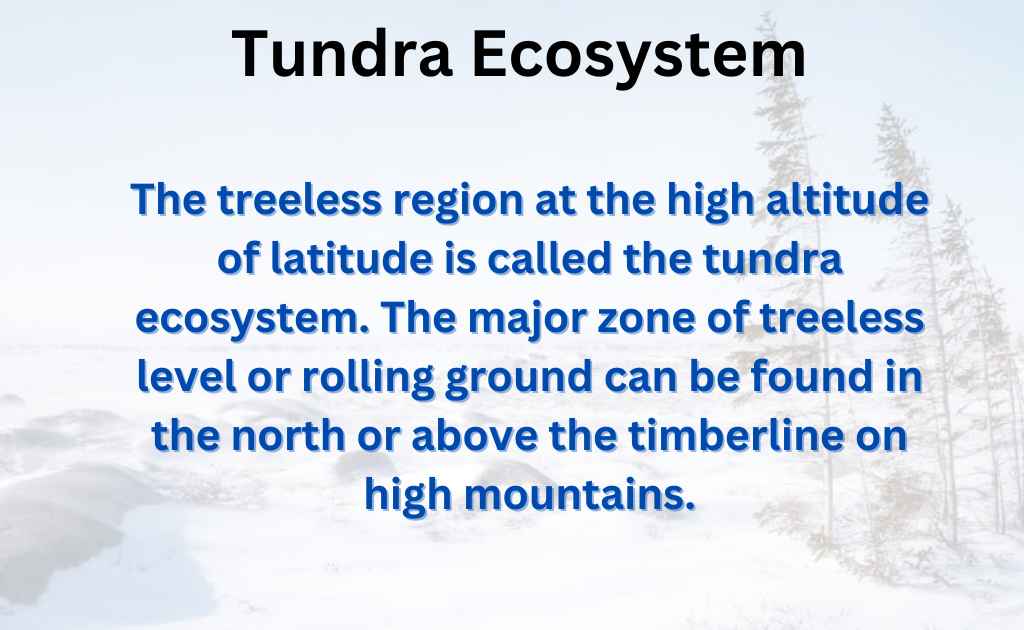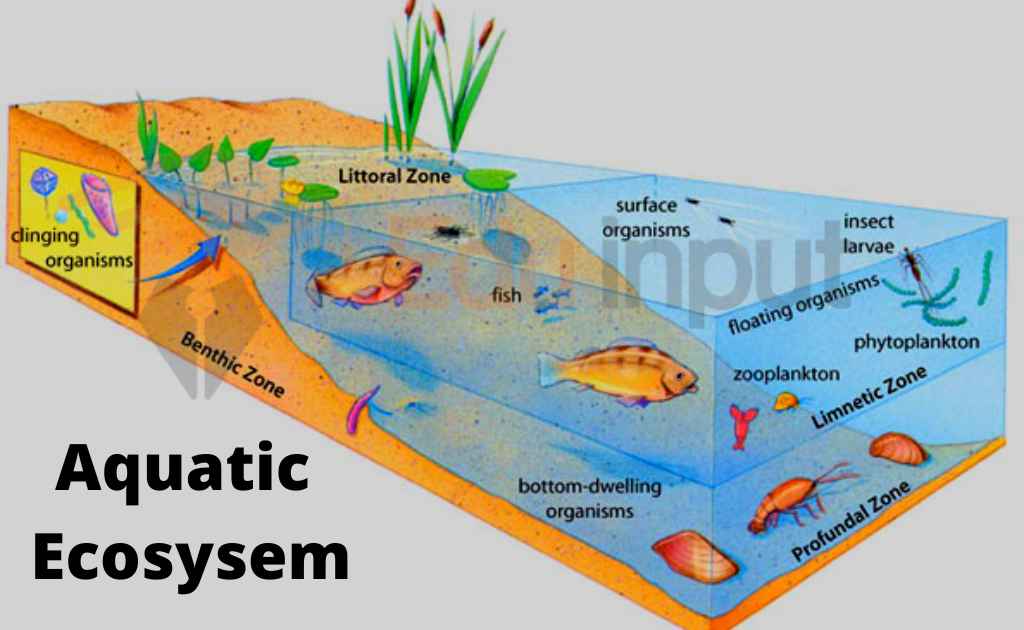Tundra Ecosystem-Types and Human Impact
The treeless region at the high altitude of latitude is called the tundra ecosystem. The major zone of treeless level or rolling ground can be found in the north or above the timberline on high mountains.
Tundra is a type of ecosystem that has large stretches of bare ground and rock, as well as patchy mantles of low vegetation such as mosses, lichens, herbs, and small shrubs. Fa
Unlike Desert ecosystems, freshwater ecosystems, and Aquatic ecosystems, they have mate-like vegetation that is found at high altitudes.
In the tundra ecosystem, the food chain operates through trophic levels,. It allows the flow of energy throughout the entire ecosystem.

| Key Points |
|---|
| 1. Tundra ecosystems are treeless regions found at high latitudes or high altitudes. 2. They exhibit a cold climate with long, freezing winters and short summers. 3. Tundra ecosystems have low biodiversity and a simple vegetation structure. 4. The tundra relies on dead organic material for energy and nutrients. 5. Biotic factors include plant species adapted to harsh conditions and animal species with specific adaptations. 6. Abiotic factors include permafrost, limited precipitation, strong winds, and nutrient-poor soils. 7. There are three types of tundra: Arctic, Alpine, and Antarctic. 8Human activities, particularly in the oil, gas, and mining industries, have significant impacts on tundra ecosystems, including habitat degradation and biodiversity loss. |
Characteristics Of Tundra Ecosystem
Tundra ecosystem shows following characteristics: :
- Cold climate
- Low biodiversity
- Simple vegetation structure
- Limited drainage
- Short growing season
- Reliance on dead organic material for energy and nutrients
- Large population fluctuations
Biotic And Abiotic Factors Of Tundra
Biotic and abiotic factors of the tundra ecosystem include:
Biotic Factors
- Plant species such as mosses, lichens, dwarf shrubs, and grasses that are adapted to the harsh conditions
- Animal species like caribou, musk oxen, Arctic foxes, lemmings, and migratory birds that have specific adaptations to survive in the tundra
Abiotic Factors
- Cold climate with long, freezing winters and short summers
- Permafrost, permanently frozen ground that affects soil composition and drainage
- Low precipitation, with less than 25 centimeters (10 inches) annually
- Strong winds that contribute to the harsh conditions
- Limited sunlight during the winter months, affecting the availability of energy for plants
- Nutrient-poor soils, resulting from the slow decomposition of organic matter due to cold temperatures
Types Of Tundra
There are three types of tundra:
Arctic Tundra
The tundra present on the high latitude is called arctic tundra. It is the last biome comes before reaching the polar ice-caps. Arctic tundra is a vast treeless region bordering the Arctic Ocean. It is present between taiga and polar ice caps. Arctic tundra is present in Northern North America, Northern Europe and Siberia (with high latitude).
Alpine Tundra
The tundra present at high altitudes is called the alpine tundra. It is present at high altitudes across the mountain above the timberline. It is present in the mountain of Karakoram and Koh Hindukush in Pakistan.
Antarctic Tundra
In the Antarctic tundra, the landscape is predominantly covered by ice and snow, with rocky areas and exposed land interspersed throughout. Vegetation in this extreme environment is limited to hardy mosses, lichens, and small flowering plants that can survive the cold temperatures and nutrient-poor soils.
Plants in Tundra Ecosystem
In tundra ecosystem, the ground is covered with small perennial flowers and dwarf willows, which grow only a few centimeters tall. Lichens, particularly the large reindeer moss, play an important role in the tundra.
The tundra’s treeless nature gives rise to a prevalence of low-growing plants. Some notable plant species found in the tundra include Arctic Moss, Arctic Willow, Caribou Moss, Labrador Tea, Arctic Poppy, Cotton Grass, as well as a diverse array of lichens and mosses.
These plants have evolved specific traits to cope with the extreme cold, short growing season, and nutrient-poor soils of the tundra. They have adapted to survive in environments where other plant types would struggle to thrive, making the tundra ecosystem a unique and fascinating biome.
Animals in Tundra Ecosystem
Animals that lives in the tundra ecosystem include the musk ox, Arctic hare, polar bear, Arctic fox, caribou, snowy owl, Arctic wolf, bald eagle, Dall sheep, stoat, harp seal, Greenland shark, lemming, moose, and narwhal.
In the tundra, standing pools provide a habitat for mosquitoes, which serve as a food source for birds such as ducks and geese. Many of these birds undertake long migrations and make their nests in the tundra during the brief summer period, where they also raise their young.
The tundra vegetation supports lemmings, which in turn attract predators like wolves, snowy owls, arctic foxes, and bears.
Human impacts On Tundra Ecosystem
Human activities, specifically in the oil, gas, and mining industries, have significant impacts on tundra ecosystems, disrupting their delicate balance.
Following human activities disrupts tundra Ecosystem:
- Drilling wells can thaw permafrost, destabilizing the environment and releasing stored carbon.
- Heavy vehicles and pipeline construction can damage the tundra soil, preventing vegetation from regrowing.
- Infrastructure development associated with oil, gas, and mining industries can lead to the loss of important habitats for tundra species.
- The disturbance caused by human activities can displace wildlife, disrupt migration patterns, and fragment populations.
- The effects of human impacts on the tundra can persist for centuries, leading to long-lasting changes in the ecosystem.
- The localized impacts of these activities are commonly observed around drilling sites, pipelines, mines, and military bases.
- Human activities in the tundra can result in habitat degradation, loss of biodiversity, and disruptions to the ecological balance.
- Construction and operation of pipelines and mines can cause habitat fragmentation and soil compaction.
- Military bases established in the tundra can alter natural drainage patterns and disturb wildlife habitats.
Latest Research About Tundra Ecosystem
- Scientists have used 100 site-years of data from 11 permafrost tundra sites to investigate how rising temperatures impact carbon uptake in northern ecosystems. They found a decrease in gross primary production (GPP) during peak summer for both vegetation classes, and a correlation between peak summer GPP and soil moisture. This suggests that decreased soil moisture may limit plant productivity and reduce the ability of tundra ecosystems to sequester carbon. [1]
- Arctic tundra, the Earth’s coldest biome, is warming three to four times faster than the global average, and it contains a significant amount of carbon that could be released into the atmosphere due to continued warming. Current evidence suggests the Arctic tundra biome is close to carbon neutral, with unclear effects on net carbon balance due to the impact of climate change. Site-level studies provide valuable insights into site-specific responses, but understanding carbon exchange across the Arctic is critical to accurately predicting future climate change. [2]
- Rising temperatures in the Arctic have led to thawing permafrost, causing changes in soil microbial activity and increasing greenhouse gas emissions. To study the impact of long-term and short-term warming on soil bacterial growth, researchers measured the growth responses of individual bacterial taxa to warming in the tundra ecosystem. Short-term warming increased average growth rates by 36%, while long-term warming increased them by 151%, with distinct responses from different bacterial taxa. [3]
- Scientists measured CO2 and CH4 fluxes in the tundra ecosystem with ponds near Cambridge Bay, Nunavut, Canada. They used chamber systems and eddy covariance methods during the summer of 2019 and 2022. They found that CO2 exchange varied more with wet grass than dry vegetation, and CH4 emission was greater near ponds. They also investigated the tundra carbon cycle using net ecosystem exchange, ecosystem respiration, and gross primary production. This study was supported by a grant from the Korean government. [4]

 written by
written by 



Leave a Reply